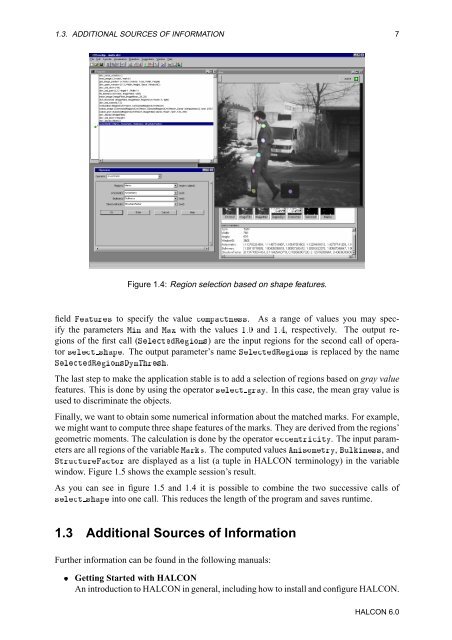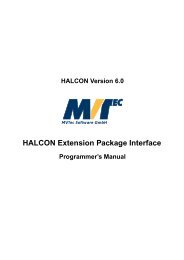Create successful ePaper yourself
Turn your PDF publications into a flip-book with our unique Google optimized e-Paper software.
1.3. ADDITIONAL SOURCES OF INFORMATION 7<br />
Figure 1.4: Region selection based on shape features.<br />
field ØÙÖ× to specify the value ÓÑÔØÒ××. As a range of values you may specify<br />
the parameters ÅÒ and ÅÜ with the values ½¼ and ½, respectively. The output regions<br />
of the first call (ËÐØÊÓÒ×) are the input regions for the second call of operator<br />
×ÐØ ×Ô. The output parameter’s name ËÐØÊÓÒ× is replaced by the name<br />
ËÐØÊÓÒ×ÝÒÌÖ×.<br />
The last step to make the application stable is to add a selection of regions based on gray value<br />
features. This is done by using the operator ×ÐØ ÖÝ. In this case, the mean gray value is<br />
used to discriminate the objects.<br />
Finally, we want to obtain some numerical information about the matched marks. For example,<br />
we might want to compute three shape features of the marks. They are derived from the regions’<br />
geometric moments. The calculation is done by the operator ÒØÖØÝ. The input parameters<br />
are all regions of the variable ÅÖ×. The computed values Ò×ÓÑØÖÝ, ÙÐÒ××, and<br />
ËØÖÙØÙÖØÓÖ are displayed as a list (a tuple in HALCON terminology) in the variable<br />
window. Figure 1.5 shows the example session’s result.<br />
As you can see in figure 1.5 and 1.4 it is possible to combine the two successive calls of<br />
×ÐØ ×Ô into one call. This reduces the length of the program and saves runtime.<br />
1.3 Additional Sources of Information<br />
Further information can be found in the following manuals:<br />
¯ Getting Started with HALCON<br />
An introduction to HALCON in general, including how to install and configure HALCON.<br />
HALCON 6.0
















